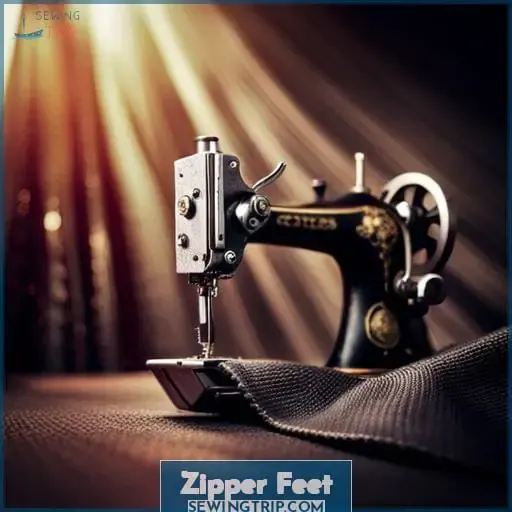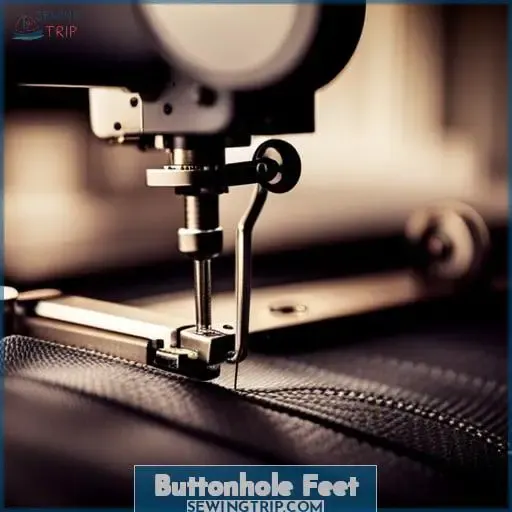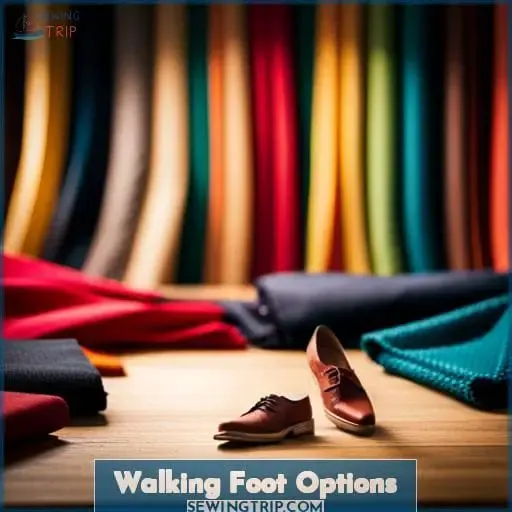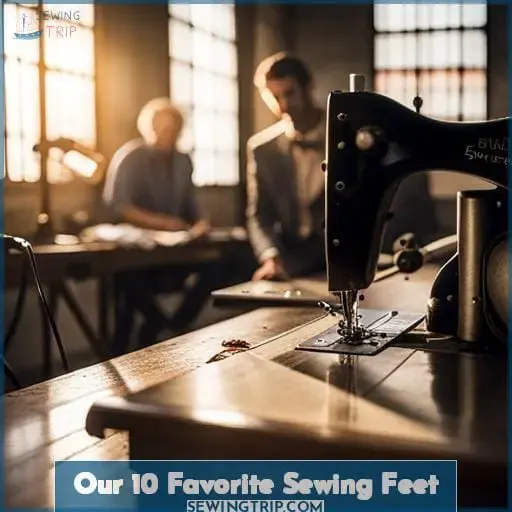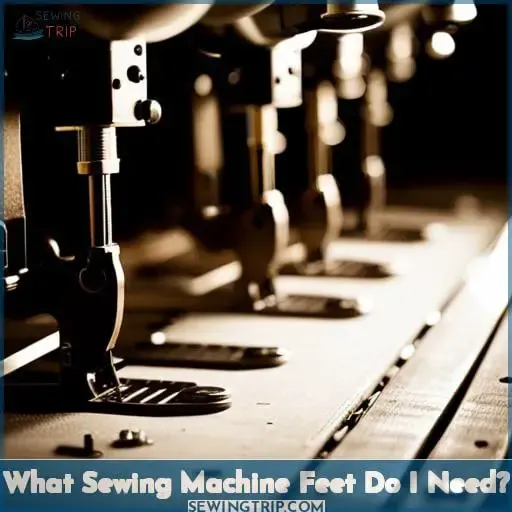This site is supported by our readers. We may earn a commission, at no cost to you, if you purchase through links.
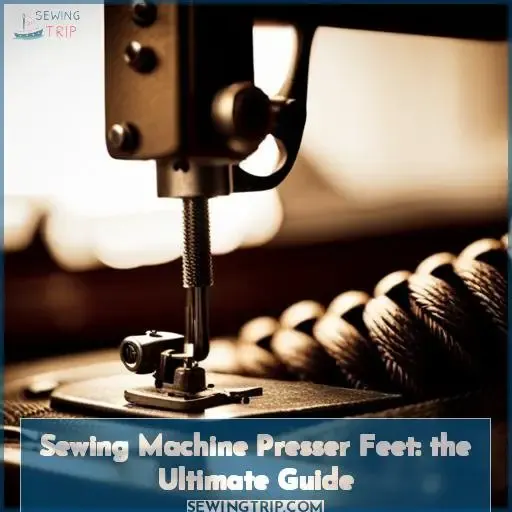 Imagine unleashing your creativity and taking control of your sewing projects like never before.
Imagine unleashing your creativity and taking control of your sewing projects like never before.
The world of sewing machine presser feet is waiting for you to explore, offering a wide range of options that can revolutionize the way you sew.
From zipper feet to buttonhole feet and walking foot options, these little tools hold the key to unlocking new techniques and adding unique details to your creations.
Get ready for a guide that will empower you with knowledge and help you become a master at using sewing machine presser feet.
Table Of Contents
Key Takeaways
- There are different types of sewing feet, such as zipper feet, buttonhole feet, specialized feet (invisible, blindstitch, walking), and essential sewing feet.
- When choosing sewing feet, it is important to consider compatibility with the machine, adjustability for various positions, and durability for long-term use.
- Sewing feet have various techniques and applications, including choosing based on machine compatibility and user reviews, using alternative presser feet for specific tasks, and utilizing feet for effective stitching without visible seams.
- Sewing feet offer benefits such as precise alignment, professional-looking finishes, even feed, fabric stability, and creative possibilities for various sewing tasks.
Zipper Feet
Now let’s talk about the essential zipper feet that every sewist should have in their collection.
The first one is the Zipper Foot, which allows you to sew close to the teeth of a zipper and is also great for adding trims.
Next, we’ve the Adjustable Zipper Foot, which gives you flexibility in moving the foot closer or further from the zip teeth depending on your project needs.
Lastly, there’s the Concealed or Invisible Zipper Foot with grooves that ensure neat sewing of invisible zippers.
These three feet are must-haves for achieving professional-looking zipper installations on your garments and accessories!
Zipper Foot
You should always use a zipper foot for sewing zippers, as it ensures precise stitching and makes trimming easier.
Here are some techniques and tips for choosing and using zipper feet:
- Choose the right size and type of zipper foot for your machine.
- Attach the zipper foot to your machine according to its instructions.
- Adjust the position of the needle to sew close to zip teeth without hitting them.
- Use alternative presser feet like an invisible zipper foot if desired or needed.
- Choosing Zipper Feet
When selecting a zipper foot, consider factors such as:
- Compatibility with your specific sewing machine model
- Ease of attachment
- Adjustability options (such as adjustable width)
- Durability
- Material (metal or plastic)
- Customer reviews
- Zipper Foot Alternatives
While a regular presser foot can be used in a pinch when sewing zippers, it may not provide optimal results compared to using a dedicated zipper foot designed specifically for this task.
- Zipper Foot Applications
A standard or universal zippered garment is usually finished by topstitching near both sides of the closure; this helps secure it in place while adding visual interest with decorative stitches if desired.
- Zipper Foot Hacks
In addition to their primary purpose of attaching zippers neatly into garments or other fabric projects securely, sturdy but lightweight fabrics can be sewn together effectively with two parallel rows following edges without any visible seam allowance since they’ll eventually join along these stitched lines when folded inwardly at each side before stitching across ends forming tubes ready make handles pockets belts loops etc.
Adjustable Zipper Foot
To further explore the world of zipper feet, let’s delve into the versatility and convenience offered by the adjustable zipper foot.
With this handy tool, you can achieve stitch precision while placing zippers exactly where you want them. The adjustable options allow for seamless insertion of zippers in various projects, from garments to bags.
Get creative with your embellishments and master buttonhole placement with ease using an adjustable zipper foot.
Concealed or Invisible Zipper Foot
The Concealed or Invisible Zipper Foot is a versatile sewing machine foot that allows you to sew neat and invisible zips effortlessly.
Proper installation ensures smooth operation, while creative applications include attaching invisible zippers on garments and home decor items.
Troubleshooting tips for this foot involve checking the alignment of the zipper pull and adjusting stitch length if needed.
Regular maintenance practices ensure optimal performance, while choosing fabrics suitable for concealed zippers enhances overall results.
Buttonhole Feet
Now, let’s talk about buttonhole feet, an essential tool for creating professional-looking buttonholes on your garments.
There are a few different types of buttonhole feet that you can use depending on your machine and preferences.
The standard buttonhole foot allows you to create manual or four-step buttonholes with zigzag stitches, while the sliding or adjustable buttonhole foot provides longer markings for accurate placement and sizing.
For those who prefer automation, the one-step buttonhole foot is perfect as it measures and creates the perfect size hole with ease.
Lastly, there’s also a specific foot designed for sewing buttons onto fabric with adjustable width options.
Standard Buttonhole Foot
Continuing the discussion on buttonhole feet, let’s now explore the functionality and benefits of the standard buttonhole foot.
Buttonhole foot techniques:
- The standard buttonhole foot allows you to create manual or four-step buttonholes using a zigzag stitch.
Creative button sewing:
- With this foot, you can sew 2 or 4-hole buttons onto your projects with adjustable width for different sizes.
Buttonhole foot alternatives:
- While there are other types of buttonhole feet available, the standard one is versatile and commonly used for various applications.
Mastering buttonholes:
- Practice using your machine’s standard buttonhole foot to perfect your technique in creating professional-looking and secure buttons on garments.
Sliding or Adjustable Buttonhole Foot
When using the sliding or adjustable buttonhole foot for your sewing machine, you can easily create precise and customizable buttonholes.
This versatile foot allows you to adjust the length of your buttonholes according to your specific needs.
With clear markings on the foot, you can accurately measure and stitch beautiful buttonholes every time.
It’s perfect for customizing stitches on various fabrics and exploring creative buttonhole designs.
One Step Buttonhole Foot
To create perfect buttonholes with ease, you can rely on the one-step buttonhole foot. This handy accessory automates the process of creating buttonholes, making it quick and efficient.
Here are some uses of the one-step buttonhole foot:
- Streamlines the creation of consistent and precise buttonholes
- Saves time by eliminating manual measurement and marking
- Suitable for a wide range of fabrics and projects
When choosing a one-step buttonhole foot, consider factors such as:
- Compatibility with your sewing machine model
- Versatility in terms of different sizes or styles of buttons
- Additional features like built-in measurements or markings
Button Sewing Foot
To sew buttons effortlessly, you can use the button sewing foot, an essential accessory that simplifies attaching 2 or 4-hole buttons with adjustable width. This versatile tool ensures precise stitching and compatibility with different button types.
With attachment techniques specifically designed for sewing machines, it allows for seamless embellishment options and decorative stitching on garments or crafts.
The button sewing foot gives you the power to master the art of button fastening with ease and precision.
Walking Foot Options
Now that we’ve covered buttonhole feet, let’s move on to the next important presser foot in our ultimate guide: walking foot options.
If you’re looking for a versatile and powerful tool to assist with quilting or handling slippery materials, then a walking foot is your answer.
The benefits of using a walking foot are numerous – it provides even feed technology, ensuring fabric stability and consistent stitching throughout your project.
Whether you’re working on heavy fabrics or delicate materials like silk or satin, the walking foot will help prevent shifting and puckering for professional-looking results every time.
It’s truly an essential accessory for any sewing machine enthusiast who desires mastery over their craft.
So why wait? Explore the world of sewing machine presser feet today by adding a reliable walking foot to your collection of must-have tools!
Our 10 Favorite Sewing Feet
Now let’s move on to discussing our 10 favorite sewing feet. These presser feet are essential tools that will enhance your sewing experience and expand your creative possibilities.
From the reliable Walking Foot and Quarter-inch Foot to the versatile Edgestitch Foot, Invisible Zipper Foot, and Blindstitch Foot, we’ll explore each foot in detail to help you choose the right ones for your projects.
Walking Foot
When it comes to our 10 favorite sewing feet, the walking foot stands out as a versatile and essential tool.
This foot is perfect for advanced techniques like quilting and stitching in the ditch. It ensures even fabric feeding with its built-in feed dogs that work in sync with your machine’s feed dogs.
The walking foot is compatible with various fabrics, making it suitable for a wide range of creative applications.
Remember to troubleshoot any issues by checking thread tension and needle size when using this handy presser foot!
Quarter-inch Foot
As we continue exploring our favorite sewing machine feet, let’s discuss the quarter-inch foot.
This essential tool is perfect for achieving precise topstitching and quarter-inch seams, ensuring your stitching is accurate and your quilting or garment detailing is on point.
The quarter-inch foot, also known as a quarter inch quilting foot or a quarter inch piecing foot, provides excellent fabric alignment and seam accuracy.
It’s like having an edge guide built right into your presser foot!
Edgestitch Foot
Continuing with our discussion of favorite sewing feet, let’s take a closer look at the Edgestitch Foot.
This versatile foot is perfect for achieving stitch precision and fabric alignment along the edge of your project. It allows you to create clean and professional seam finishes, whether it’s stitching in the ditch or edgestitching hems.
The Edgestitch Foot also offers versatility by enabling zigzag stitches for raw edges or using it with a rolled hem foot for neat hemming techniques.
Invisible Zipper Foot
Use the invisible zipper foot for seamless and professional insertion of zippers onto your garments.
This specialized foot glides smoothly along the zipper coils, ensuring precise stitch alignment and avoiding any visible stitches on the outside of your project.
The invisible zipper foot is compatible with various fabrics, from lightweight to heavy materials.
For best results, remember to adjust your machine settings accordingly and practice proper insertion techniques.
Get ready to level up your sewing skills with this essential tool!
Blindstitch Foot
To achieve invisible hems and professional finishes, the blindstitch foot is a must-have addition to your sewing machine.
This specialized foot allows you to create perfectly hidden stitches that are virtually undetectable on the right side of fabric.
With the blindstitch foot, you can easily hem garments with precision and finesse, giving your projects a polished look.
It’s an essential tool for mastering stitching techniques, fabric hemming, seam finishes, invisible hems,and garment detailing.
Benefits of the blindstitch foot:
- Perfectly hidden stitches
- Professional finish
- Polished garment detailing
What Sewing Machine Feet Do I Need?
Now that you understand the different types of sewing machine feet and their functions, let’s discuss what sewing machine feet you actually need.
The most common sewing machine fittings include:
- Zipper feet
- Buttonhole feet
- Specialized embellishment feet such as piping foot or appliqué foot
- Versatile presser feet like walking foot or quarter-inch foot
Each of these serves a specific purpose in your projects and can make your stitching more efficient and professional-looking. By understanding the uses of different sewing machine feet, you can determine which ones are essential for your needs.
Most Common Sewing Machine Fittings
You’ll need to determine which sewing machine feet are most commonly used for your specific projects.
| Sewing Machine Foot | Function | Compatible with |
|---|---|---|
| Piping Foot | Creates precise piping | Brother, Janome, Pfaff |
| Embroidery Foot | For embroidery work | Husqvarna Viking, Janome, Pfaff |
How to Attach Different Feet
Attach the desired presser foot to your sewing machine by following these simple steps:
- Turn off the sewing machine and unplug it for safety.
- Locate the presser foot holder on your machine.
- Align the pin on the presser foot with the hole in the holder.
- Lower or snap-on, depending on your machine model.
Remember to consult your manual for specific instructions and troubleshooting tips. Regular maintenance is crucial for optimal performance. Experimenting with different feet like cording, ruffler, gathering, roller, and couching can unlock endless creative possibilities.
Uses of Different Sewing Machine Feet
You often need different sewing machine feet for various stitching techniques.
The cording foot allows you to create creative embellishments with cords, elastic thread, and wool.
Use the ribbon or sequin foot to easily sew ribbons, sequins, and trims onto your projects.
For precision sewing in quilting or piecing blocks accurately, the ruler foot is essential.
When it comes to decorative stitches and appliqué work on different fabrics, the darning foot is a go-to choice for many sewers.
Frequently Asked Questions (FAQs)
Are sewing machine feet compatible with all sewing machine brands?
Yes, sewing machine feet are designed to be compatible with specific brands and models.
It’s important to check compatibility charts and purchase feet specifically made for your machine brand like Brother, Janome, Pfaff or Husqvarna.
Can I use a zipper foot for sewing piping?
Absolutely!
While it may sound outrageous, you can totally use a zipper foot for sewing piping. It adds an extra flair to your projects and unleashes your creative power in the world of sewing mastery.
Are there specific presser feet for sewing different types of buttons?
Yes, there are specific presser feet designed for sewing different types of buttons.
These specialized feet make it easier to attach buttons with adjustable width and ensure a professional finish.
What are the benefits of using a walking foot?
Using a walking foot gives you the power to conquer tricky fabrics like knits and slippery materials.
It ensures even feeding for seamless stitching, making quilting and matching plaids a breeze.
Master your sewing projects with this liberating tool!
How do I choose the right sewing machine feet for my projects?
To choose the right sewing machine feet for your projects, consider your specific needs.
Look at compatibility charts and explore options like zipper, buttonhole, specialized embellishment feet.
Embrace the power of mastery by experimenting and expanding your creative possibilities with different presser feet.
Conclusion
In your journey to become a sewing master, the world of sewing machine presser feet awaits you. These little tools hold the key to unlocking new techniques and adding unique details to your creations.
From zipper feet to buttonhole feet and walking foot options, there’s a wide range of options for you to explore and unleash your creativity.
With the knowledge and empowerment gained from this ultimate guide, you’ll be well-equipped to take control of your sewing projects like never before.
So, get ready to dive into the world of sewing machine presser feet and elevate your sewing skills to new heights.

